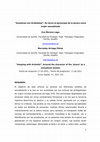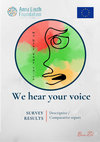Papers by Mercedes Arriaga Flórez
Ma misognia en la cultura y en la sociedad, 2023
Andaluzas ocultas. Medio siglo de mujeres intectuales (1900-1950), 2023
El poemario De Mar a Mar de María Enciso publicado en 1946
en México se distingue por abordar tem... more El poemario De Mar a Mar de María Enciso publicado en 1946
en México se distingue por abordar temas como el exilio, la
naturaleza y la remembranza, elementos que configuran una voz
poética dolorida y desplazada debido al exilio y comprometida
con la denuncia de la guerra y del fascismo. Al mismo tiempo la
poeta idealiza y reconstruye la patria lejana a través de una
memoria visual que comprende imágenes de paisajes, ciudades
y cuerpos
Scrittrici in esilio tra Ottocento e Novecento, 2022
Núm. 19 (2021): Monográfico: Voces masculinas en la Querelle des Femmes , 2021
Cartaphilus
Núm. 19 (2021): Monográfico: Voces masculinas en la Querelle des Femmes
Coordinado ... more Cartaphilus
Núm. 19 (2021): Monográfico: Voces masculinas en la Querelle des Femmes
Coordinado por Mercedes Arriaga Flórez (Universidad de Sevilla)
Publicado: 19-04-2022

Estudios Románicos, Volumen 31, , 2022
This article analyses the figures of women and men in the text of the Orazione in lode alle donne... more This article analyses the figures of women and men in the text of the Orazione in lode alle donne (1545), written by Alessandro Piccolomini, in which he accuses his colleagues, literary friends, of not knowing how to treat women well while he, alternatively, puts himself as their defender. The rhetorical game has its origins in these recipients and interlocutors
of this work who have a familial bond, a friendship or literary tastes and political tendencies in common with the author. The author’s ironic and ambiguous attitude towards the concepts of feminine and masculine is closely linked to the atmosphere of playfulness in the Accademia degli Intronati and the complicity between its members, which allows double
engenders and a mock dialectical clash, in which the author represents his companions as characters of a farce, characterized by their misogynistic ideas that are “dicted” in the text to be “contradicted” by Piccolomini. The text thus develops under the sign of the splitting masculinity and femininity: courtly men versus vulgar men, virtuous women versus vicious
women within the context of idealised love against carnal love.

Tessere le relazioni. Scritti in onore di Marisa Forcina, 2022
Nel romanzo di Olga Tokarczuk Prawiek i inne czasy (1996)1, tradotto in italiano con due titoli d... more Nel romanzo di Olga Tokarczuk Prawiek i inne czasy (1996)1, tradotto in italiano con due titoli diversi Dio, il tempo, gli uomini e gli angeli (1999) e Nella quiete del tempo (2013 e 2020)2 il tempo acronico si profila come un elemento centrale. La struttura temporale-narrativa presente in Nella quiete del tempo di- venta l’espressione di un pluralismo che si cifra a livello simbolico di una costellazione di figure femminili indipendenti fra di loro ma, facenti parte delle manifestazioni della Grande Madre o del Gran Femminile5. In que- sto contesto, la differenza sessuale, «la più basilare e universale di tutte le differenze umane»6, diventa elemento fondamentale per la tessitura di unordine etico-politico più libero e giusto7, che non coinvolge soltanto le donne ma anche l’ambiente naturale in cui si muovono e agiscono.
Libro - Literatura, Lenguajes e Imaginarios Sociales, 2022
presentaciones de la mujer y lo femenino en la literatura occidental. Trazado genealógico, cruces... more presentaciones de la mujer y lo femenino en la literatura occidental. Trazado genealógico, cruces discursivos y lecturas situadas 1 , parte de entender a la literatura como un acto creativo en íntima relación con la sociedad que la produce y/o recibe porque expone sus valores, representaciones e imaginarios.

Quaderni d' Italianistica, 2021
L’obiettivo di questo articolo è analizzare alcuni aspetti
del ‘mondo alla rovescia’ presenti nel... more L’obiettivo di questo articolo è analizzare alcuni aspetti
del ‘mondo alla rovescia’ presenti nel Dialogo della bella creanza delle
donne (1539) di Alessandro Piccolomini, a partire della caratterizzazione
comica delle sue protagoniste. Raffaella e Margherita, hanno
tratti in comune con altri personaggi femminili della Commedia del
Cinquecento, entrando a far parte della schiera delle donne trasgressive,
insidiose e meretrici, con un ruolo importante nella rappresentazione
rinascimentale burlesca ed ironica. Raffaella interpreta il tipo
della mezzana e Margherita quello della malmaritata e il loro binomio
antitetico è costruito sullo spirito parodico che affonda le sue radici
nei riti sovversivi del Carnevale e del commento paradossale. Margherita
si trasforma in un doppio aberrante della moglie virtuosa, mentre
Raffaella è già una donna deformata, in quanto mezzana e prostituta.
Piccolomini gioca, dunque, sull’inversione che evidenzia i confini dei
ruoli sociali e di genere sfidando le regole della cultura del suo tempo.
Revista Internacional de Pensamiento político, 2021
The Italian writers involved in the Women’s Question, 14th-17th
centuries, are a scarcely known l... more The Italian writers involved in the Women’s Question, 14th-17th
centuries, are a scarcely known link of feminist ideas both in the context of
the Italian and European cultures, due to the lack of modern editions, critical
studies, and translations. This article deals with some theoretical and textual
issues related to this philosophical-literary debate, taking into consideration a
global perspective that includes both women and men writers. It also presents
a bibliographical review of the studies that have been carried out on this subject
internationally from its beginnings in the 1980s to the present day, in which
the plurality of approaches and the evolution of this field of study, which is still
under construction, can be appreciated.
¿Un legendario caballero espaúol o un malogrado poeta italiano, víctima de una absurda venganza p... more ¿Un legendario caballero espaúol o un malogrado poeta italiano, víctima de una absurda venganza política?".
Verde acqua si apre con la descrizione di uno di questi luoghi liminari, l’atrio, dove la bambina... more Verde acqua si apre con la descrizione di uno di questi luoghi liminari, l’atrio, dove la bambina può allo stesso tempo esplorare senza uscire di casa, in uno spazio a lei destinato, perché appunto, è, ma non è la casa. L’atrio è un “luogo vuoto”, (“Perché era quasi privo di suppellettili”, ci dice Marisa Madieri), che si corrisponde con la “profondità del tempo”, che apre il secondo capitolo, un altro spazio vuoto, direbbe Ricoeur, da dove “poter volgere lo sguardo su di noi stessi” (Ricoeur, 1989: 58). Il luogo fisico, delimitato, dell’esplorazione sensoriale nella bambina, si trasforma in qualcosa senza confini “la profondità del tempo, nella donna”, che permette le scorribande del pensiero:
Segni E Comprensione, Dec 1, 1996
segni e comprensione, 2021
Essay's aim is to examine, through the symbolism of writing and the metaphors of Amalia Guglielmi... more Essay's aim is to examine, through the symbolism of writing and the metaphors of Amalia Guglielminetti, the liminal condition of female figures and their capacity to transform, indicative of the difficulties experienced by women writers in the first half of the twentieth century.
Philologia Hispalensis, 1991
Philologia Hispalensis, 1994

Tonos digital, 2021
The aim of this article is to analyse the different areas of sexualisation to which the protagoni... more The aim of this article is to analyse the different areas of sexualisation to which the protagonists of four picaresque 17th century novels are subjected by their authors. They are degraded characters who embody all the vices considered to be feminine and in whom the maternal inheritance determines their destiny and their moral depth, aggravated by a non-Christian ethnic origin. The picaras are shown to us as sexualised women in all their spheres of action: they carry out jobs directly or indirectly related to the sexual sphere, but also, by transgressing all the rules of behaviour and circulation imposed on women, they are going to identify themselves with prostitutes, in the broadest sense of women who wander into public spaces without any modesty. The cheeky ones will be window dressers, walkers, lovers of dancing or singing and, above all, loose tongues. The impudent character, which relates sexuality to their skilful use of language, is reflected in their condition as narrators of their own stories, but also in their characterisation as readers or writers.

"We hear your voice" - Survey results, 2021
This study is part of the “We hear your voices project funded by
the Anna Lindh Euro-Mediterrane... more This study is part of the “We hear your voices project funded by
the Anna Lindh Euro-Mediterranean Foundation for intercultural
dialogue initiatives. The project is carried out by AWMC - Arab
Women Media Center, Jordan, Arciragazzi Portici "Utopia
Attanasio" APS, Italy, Loesje Palestine, Palestine, BENILDE
Culturas y Mujeres, Spain.
"We hear your voices" is aimed at youth workers, media workers,
the young population, women, and immigrant communities and
has been developed over 10 months between 2020 and 2021.
Two of the main projects objectives are studying the phenomenon
of gender violence among the youth of Italy, Spain, Jordan, and
Palestine and being able to compare the main types of this
violence, that occur in these different socio-cultural contexts.
For this purpose, a questionnaire translated into Italian, Spanish
and Arabic, has been designed and addressed to people between 18
and 35 years old. The questionnaire has been distributed
throughout January and February 2021, through an online form
published on various social media platforms. Once all data was
collected, a description of the results has been made for each
country involved.
The second step was analyzing the results obtained by each
country and comparing the main typologies and characteristics of
the phenomenon.
In Italian, Arabic, Spanish and English
RSEI, 2019
This article intends to analise Laura Terracina’s Discorso sopra il Principio di tutti i canti d’... more This article intends to analise Laura Terracina’s Discorso sopra il Principio di tutti i canti d’Orlando furioso in the context of Querelle des Femmes. The reworking and reinter- pretation of the Ariosto work by the Neapolitan women writer constitutes the epic piece of the Querelle, introducing fundamental topics within the debate on dignity and female excellence as ge- nealogy, sorority, auctoritas, defence against male attacks and the denunciation of violence against women that can be found in other previous and later women writers.











Uploads
Papers by Mercedes Arriaga Flórez
en México se distingue por abordar temas como el exilio, la
naturaleza y la remembranza, elementos que configuran una voz
poética dolorida y desplazada debido al exilio y comprometida
con la denuncia de la guerra y del fascismo. Al mismo tiempo la
poeta idealiza y reconstruye la patria lejana a través de una
memoria visual que comprende imágenes de paisajes, ciudades
y cuerpos
Núm. 19 (2021): Monográfico: Voces masculinas en la Querelle des Femmes
Coordinado por Mercedes Arriaga Flórez (Universidad de Sevilla)
Publicado: 19-04-2022
of this work who have a familial bond, a friendship or literary tastes and political tendencies in common with the author. The author’s ironic and ambiguous attitude towards the concepts of feminine and masculine is closely linked to the atmosphere of playfulness in the Accademia degli Intronati and the complicity between its members, which allows double
engenders and a mock dialectical clash, in which the author represents his companions as characters of a farce, characterized by their misogynistic ideas that are “dicted” in the text to be “contradicted” by Piccolomini. The text thus develops under the sign of the splitting masculinity and femininity: courtly men versus vulgar men, virtuous women versus vicious
women within the context of idealised love against carnal love.
del ‘mondo alla rovescia’ presenti nel Dialogo della bella creanza delle
donne (1539) di Alessandro Piccolomini, a partire della caratterizzazione
comica delle sue protagoniste. Raffaella e Margherita, hanno
tratti in comune con altri personaggi femminili della Commedia del
Cinquecento, entrando a far parte della schiera delle donne trasgressive,
insidiose e meretrici, con un ruolo importante nella rappresentazione
rinascimentale burlesca ed ironica. Raffaella interpreta il tipo
della mezzana e Margherita quello della malmaritata e il loro binomio
antitetico è costruito sullo spirito parodico che affonda le sue radici
nei riti sovversivi del Carnevale e del commento paradossale. Margherita
si trasforma in un doppio aberrante della moglie virtuosa, mentre
Raffaella è già una donna deformata, in quanto mezzana e prostituta.
Piccolomini gioca, dunque, sull’inversione che evidenzia i confini dei
ruoli sociali e di genere sfidando le regole della cultura del suo tempo.
centuries, are a scarcely known link of feminist ideas both in the context of
the Italian and European cultures, due to the lack of modern editions, critical
studies, and translations. This article deals with some theoretical and textual
issues related to this philosophical-literary debate, taking into consideration a
global perspective that includes both women and men writers. It also presents
a bibliographical review of the studies that have been carried out on this subject
internationally from its beginnings in the 1980s to the present day, in which
the plurality of approaches and the evolution of this field of study, which is still
under construction, can be appreciated.
the Anna Lindh Euro-Mediterranean Foundation for intercultural
dialogue initiatives. The project is carried out by AWMC - Arab
Women Media Center, Jordan, Arciragazzi Portici "Utopia
Attanasio" APS, Italy, Loesje Palestine, Palestine, BENILDE
Culturas y Mujeres, Spain.
"We hear your voices" is aimed at youth workers, media workers,
the young population, women, and immigrant communities and
has been developed over 10 months between 2020 and 2021.
Two of the main projects objectives are studying the phenomenon
of gender violence among the youth of Italy, Spain, Jordan, and
Palestine and being able to compare the main types of this
violence, that occur in these different socio-cultural contexts.
For this purpose, a questionnaire translated into Italian, Spanish
and Arabic, has been designed and addressed to people between 18
and 35 years old. The questionnaire has been distributed
throughout January and February 2021, through an online form
published on various social media platforms. Once all data was
collected, a description of the results has been made for each
country involved.
The second step was analyzing the results obtained by each
country and comparing the main typologies and characteristics of
the phenomenon.
In Italian, Arabic, Spanish and English
en México se distingue por abordar temas como el exilio, la
naturaleza y la remembranza, elementos que configuran una voz
poética dolorida y desplazada debido al exilio y comprometida
con la denuncia de la guerra y del fascismo. Al mismo tiempo la
poeta idealiza y reconstruye la patria lejana a través de una
memoria visual que comprende imágenes de paisajes, ciudades
y cuerpos
Núm. 19 (2021): Monográfico: Voces masculinas en la Querelle des Femmes
Coordinado por Mercedes Arriaga Flórez (Universidad de Sevilla)
Publicado: 19-04-2022
of this work who have a familial bond, a friendship or literary tastes and political tendencies in common with the author. The author’s ironic and ambiguous attitude towards the concepts of feminine and masculine is closely linked to the atmosphere of playfulness in the Accademia degli Intronati and the complicity between its members, which allows double
engenders and a mock dialectical clash, in which the author represents his companions as characters of a farce, characterized by their misogynistic ideas that are “dicted” in the text to be “contradicted” by Piccolomini. The text thus develops under the sign of the splitting masculinity and femininity: courtly men versus vulgar men, virtuous women versus vicious
women within the context of idealised love against carnal love.
del ‘mondo alla rovescia’ presenti nel Dialogo della bella creanza delle
donne (1539) di Alessandro Piccolomini, a partire della caratterizzazione
comica delle sue protagoniste. Raffaella e Margherita, hanno
tratti in comune con altri personaggi femminili della Commedia del
Cinquecento, entrando a far parte della schiera delle donne trasgressive,
insidiose e meretrici, con un ruolo importante nella rappresentazione
rinascimentale burlesca ed ironica. Raffaella interpreta il tipo
della mezzana e Margherita quello della malmaritata e il loro binomio
antitetico è costruito sullo spirito parodico che affonda le sue radici
nei riti sovversivi del Carnevale e del commento paradossale. Margherita
si trasforma in un doppio aberrante della moglie virtuosa, mentre
Raffaella è già una donna deformata, in quanto mezzana e prostituta.
Piccolomini gioca, dunque, sull’inversione che evidenzia i confini dei
ruoli sociali e di genere sfidando le regole della cultura del suo tempo.
centuries, are a scarcely known link of feminist ideas both in the context of
the Italian and European cultures, due to the lack of modern editions, critical
studies, and translations. This article deals with some theoretical and textual
issues related to this philosophical-literary debate, taking into consideration a
global perspective that includes both women and men writers. It also presents
a bibliographical review of the studies that have been carried out on this subject
internationally from its beginnings in the 1980s to the present day, in which
the plurality of approaches and the evolution of this field of study, which is still
under construction, can be appreciated.
the Anna Lindh Euro-Mediterranean Foundation for intercultural
dialogue initiatives. The project is carried out by AWMC - Arab
Women Media Center, Jordan, Arciragazzi Portici "Utopia
Attanasio" APS, Italy, Loesje Palestine, Palestine, BENILDE
Culturas y Mujeres, Spain.
"We hear your voices" is aimed at youth workers, media workers,
the young population, women, and immigrant communities and
has been developed over 10 months between 2020 and 2021.
Two of the main projects objectives are studying the phenomenon
of gender violence among the youth of Italy, Spain, Jordan, and
Palestine and being able to compare the main types of this
violence, that occur in these different socio-cultural contexts.
For this purpose, a questionnaire translated into Italian, Spanish
and Arabic, has been designed and addressed to people between 18
and 35 years old. The questionnaire has been distributed
throughout January and February 2021, through an online form
published on various social media platforms. Once all data was
collected, a description of the results has been made for each
country involved.
The second step was analyzing the results obtained by each
country and comparing the main typologies and characteristics of
the phenomenon.
In Italian, Arabic, Spanish and English
la primera parte del libro Raíz al viento, editado en una primera
y única edición en México, en 19472. María Enciso los agrupa
bajo la denominación de “ensayos”. Nuestra elección de
publicarlos nuevamente responde a la necesidad de dar a
conocer una faceta olvidada de nuestra autora: la de crítico
literario militante, que practica este género literario partiendo de
presupuestos estéticos y políticos dictados por su condición de
escritora republicana exiliada.
ensayista onubense que gozó de cierta fama en los círculos
literarios de principio del siglo XX. Su obra, en prosa y en
versos, aparece en distintos periódicos de la época, entre ellos
La Correspondencia de España, La Alhambra y La Época, así
como las reseñas a sus relatos y las composiciones que le
dedicaron sus contemporáneos, como Antonio de Zayas y
Manuel Machado. Pese al reconocimiento que tuvo en esos
años, los estudios sobre la vida y la obra de Casilda de Antón
del Olmet son escasos.
A voi soldati futuri dico la nostra guerra (1916)1 e Il figlio alla guerra (1917)2, ma la nostra attenzione si rivolge agli articoli e alle note pubblicati in diversi giornali negli anni del conflitto mondiale e nell’immediato dopoguerra. Adoperando gli strumenti concettuali della storia delle emozioni, il nostro intervento intende analizzare la retorica presente in questi brevi scritti che, per la loro intensità emotiva, presentano caratteristiche in comune con le lettere e cartoline spedite e dirette al fronte e con altri testi della propaganda politica